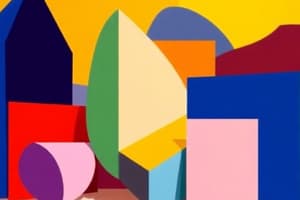Podcast
Questions and Answers
What is a point in geometry?
What is a point in geometry?
- A collection of points extending infinitely in two directions
- A portion of a line bounded by two points
- An infinitesimally small entity representing a location in space (correct)
- A line segment with a definite length
Which geometric object is defined by its (x, y) coordinates?
Which geometric object is defined by its (x, y) coordinates?
- Line Segment
- Point (correct)
- Ray
- Plane
What defines a line segment in geometry?
What defines a line segment in geometry?
- A portion of a line with no definite length
- An infinitesimally small entity representing a location in space
- A collection of points extending infinitely in two directions
- A portion of a line with a definite length bounded by two points (correct)
Which geometric object extends infinitely in two directions?
Which geometric object extends infinitely in two directions?
What is the fundamental difference between a line and a line segment?
What is the fundamental difference between a line and a line segment?
What is a ray in the context of a coordinate plane?
What is a ray in the context of a coordinate plane?
How is a line segment defined in the context of a coordinate plane?
How is a line segment defined in the context of a coordinate plane?
What defines a plane in the context of a coordinate plane?
What defines a plane in the context of a coordinate plane?
How does a ray differ from a line segment?
How does a ray differ from a line segment?
In terms of geometry, what characteristic best describes a line?
In terms of geometry, what characteristic best describes a line?
Flashcards are hidden until you start studying
Study Notes
Geometric Figures: Understanding Points, Lines, Line Segments, Rays, and Planes
Geometry, as a branch of mathematics, focuses on shapes, sizes, and the relative positions of figures. It is divided into two main branches: plane geometry (two-dimensional) and solid geometry (three-dimensional). Before delving into specific shapes, it is crucial to understand the fundamental building blocks of geometric figures: point, line, line segment, ray, and plane. These concepts provide the foundation for understanding more complex shapes and relationships between them.
Point
A point is an infinitesimally small entity that represents a location or position in space. In geometry, points are typically represented by dots and can be used to define other geometric objects. For example, in a coordinate plane, a point is defined by its (x, y) coordinates.
Line
A line is a collection of points that extends infinitely in two directions. It has no thickness and is represented by an arrow over the letters depicting the endpoints. A line can also be considered as the smallest length of a geometric figure. In the context of a coordinate plane, a line is defined by an equation.
Line Segment
A line segment is a portion of a line that has a definite length and is bounded by two points. It is represented by a line with two arrows over the letters depicting the endpoints. A line segment can also be defined as the shortest distance between two points. In the context of a coordinate plane, a line segment is defined by its endpoints.
Ray
A ray is a collection of points that extends infinitely in one direction from a given point, called its origin. It is represented by a single arrow over the letters depicting the origin and the direction of extension. A ray can also be considered as a part of a line that has only one endpoint. In the context of a coordinate plane, a ray is defined by its origin and the direction of extension.
Plane
A plane is a flat, level surface that extends infinitely in all directions. It is the simplest three-dimensional geometric figure and can be thought of as a two-dimensional space. A plane can be defined by a linear equation, such as y = mx + b, where m and b are constants. In the context of a coordinate plane, a plane is defined by an equation that relates the x and y coordinates.
These basic geometric concepts serve as the foundation for understanding more complex shapes and relationships between them in both plane and solid geometry.
Studying That Suits You
Use AI to generate personalized quizzes and flashcards to suit your learning preferences.




